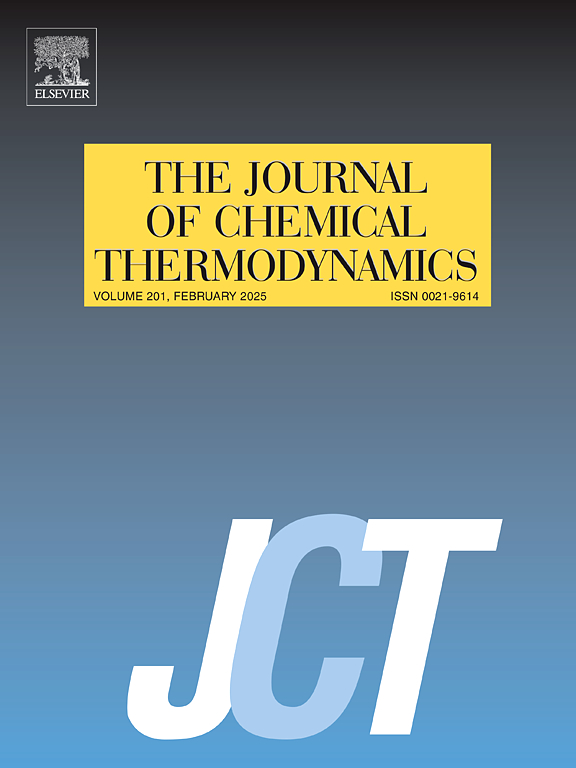Solubility determination, correlation, solvent effect and thermodynamic properties of tolnaftate in ten mono-solvents and binary solvent systems from 283.15 K to 328.15 K
IF 2.2
3区 工程技术
Q3 CHEMISTRY, PHYSICAL
引用次数: 0
Abstract
Tolnaftate (TNF) is a local antifungal agent. The determination of its solubility can serve as a valuable reference for its crystallization and formulation design, an area that has not yet been comprehensively investigated. In this study, the static method was carried out to determine the solubility of TNF in 10 mono-solvents (methanol, ethanol, n-propanol, isopropanol, n-butanol, isobutanol, n-octanol, 1,2-propanediol, ethylene glycol, acetic acid) and the binary mixed solvents (acetic acid + ethylene glycol) at T = (283.15 to 328.15) K and P = 0.1 MPa. The experiment results showed that TNF dissolves best in acetic acid and worst in ethylene glycol among investigated mono-solvents. And the solubility in mixed solvents was observed to increase as the mole ratio of acetic acid augments. In all solvents, there is obviously increase in the solubility of TNF as temperature elevates. The Apelblat model, van't Hoff model, Jouyban model, GCM model, Sun model and Apelblat-Jouyban-Acree model were used to fit the solubility values. And the root mean square deviation (RMSD) between the calculated values and experimental values are less than 0.025 %, showing that the experimental values are accurate and the models have good fitting effects. At the same time, X-ray powder diffraction (PXRD) tests confirmed that the absence of crystal transformation during the process of TNF dissolution. In addition, according to the KAT-LSER model, the influence of solute-solvent interactions on the solubility of TNF exceeds that of solvent-solvent interactions. The thermodynamic properties including entropy (ΔH0sol), enthalpy (ΔS0sol), Gibbs free energy (ΔG0sol), enthalpy contribution (%ξH) and entropy contribution (%ξS) were calculated, which proved that dissolution process of TNF is endothermic and entropy-driven, and enthalpy mainly affects Gibbs free energy.

甲苯酰萘酸在283.15 ~ 328.15 K范围内十种单溶剂和二元溶剂体系中的溶解度测定、相关性、溶剂效应和热力学性质
TNF是一种局部抗真菌药物。其溶解度的测定可以为其结晶和配方设计提供有价值的参考,这一领域尚未得到全面的研究。本研究采用静态法测定了TNF在10种单溶剂(甲醇、乙醇、正丙醇、异丙醇、正丁醇、异丁醇、正辛醇、1,2-丙二醇、乙二醇、乙酸)和二元混合溶剂(乙酸+乙二醇)中的溶解度,条件为T = (283.15 ~ 328.15) K, P = 0.1 MPa。实验结果表明,在所研究的单溶剂中,TNF在乙酸中的溶解性最好,在乙二醇中的溶解性最差。在混合溶剂中的溶解度随着乙酸摩尔比的增大而增大。在所有溶剂中,TNF的溶解度随温度升高而明显增加。采用Apelblat模型、van't Hoff模型、Jouyban模型、GCM模型、Sun模型和Apelblat-Jouyban- acree模型拟合溶解度值。计算值与实验值的均方根偏差(RMSD)小于0.025%,表明实验值准确,模型拟合效果良好。同时,x射线粉末衍射(PXRD)测试证实了TNF溶解过程中没有发生晶体转变。此外,根据KAT-LSER模型,溶质-溶剂相互作用对TNF溶解度的影响超过了溶剂-溶剂相互作用。计算了其热力学性质,包括熵(ΔH0sol)、焓(ΔS0sol)、吉布斯自由能(ΔG0sol)、焓贡献(%ξH)和熵贡献(%ξS),证明了TNF的溶解过程是吸热的、熵驱动的,其中焓主要影响吉布斯自由能。
本文章由计算机程序翻译,如有差异,请以英文原文为准。
求助全文
约1分钟内获得全文
求助全文
来源期刊

Journal of Chemical Thermodynamics
工程技术-热力学
CiteScore
5.60
自引率
15.40%
发文量
199
审稿时长
79 days
期刊介绍:
The Journal of Chemical Thermodynamics exists primarily for dissemination of significant new knowledge in experimental equilibrium thermodynamics and transport properties of chemical systems. The defining attributes of The Journal are the quality and relevance of the papers published.
The Journal publishes work relating to gases, liquids, solids, polymers, mixtures, solutions and interfaces. Studies on systems with variability, such as biological or bio-based materials, gas hydrates, among others, will also be considered provided these are well characterized and reproducible where possible. Experimental methods should be described in sufficient detail to allow critical assessment of the accuracy claimed.
Authors are encouraged to provide physical or chemical interpretations of the results. Articles can contain modelling sections providing representations of data or molecular insights into the properties or transformations studied. Theoretical papers on chemical thermodynamics using molecular theory or modelling are also considered.
The Journal welcomes review articles in the field of chemical thermodynamics but prospective authors should first consult one of the Editors concerning the suitability of the proposed review.
Contributions of a routine nature or reporting on uncharacterised materials are not accepted.
 求助内容:
求助内容: 应助结果提醒方式:
应助结果提醒方式:


